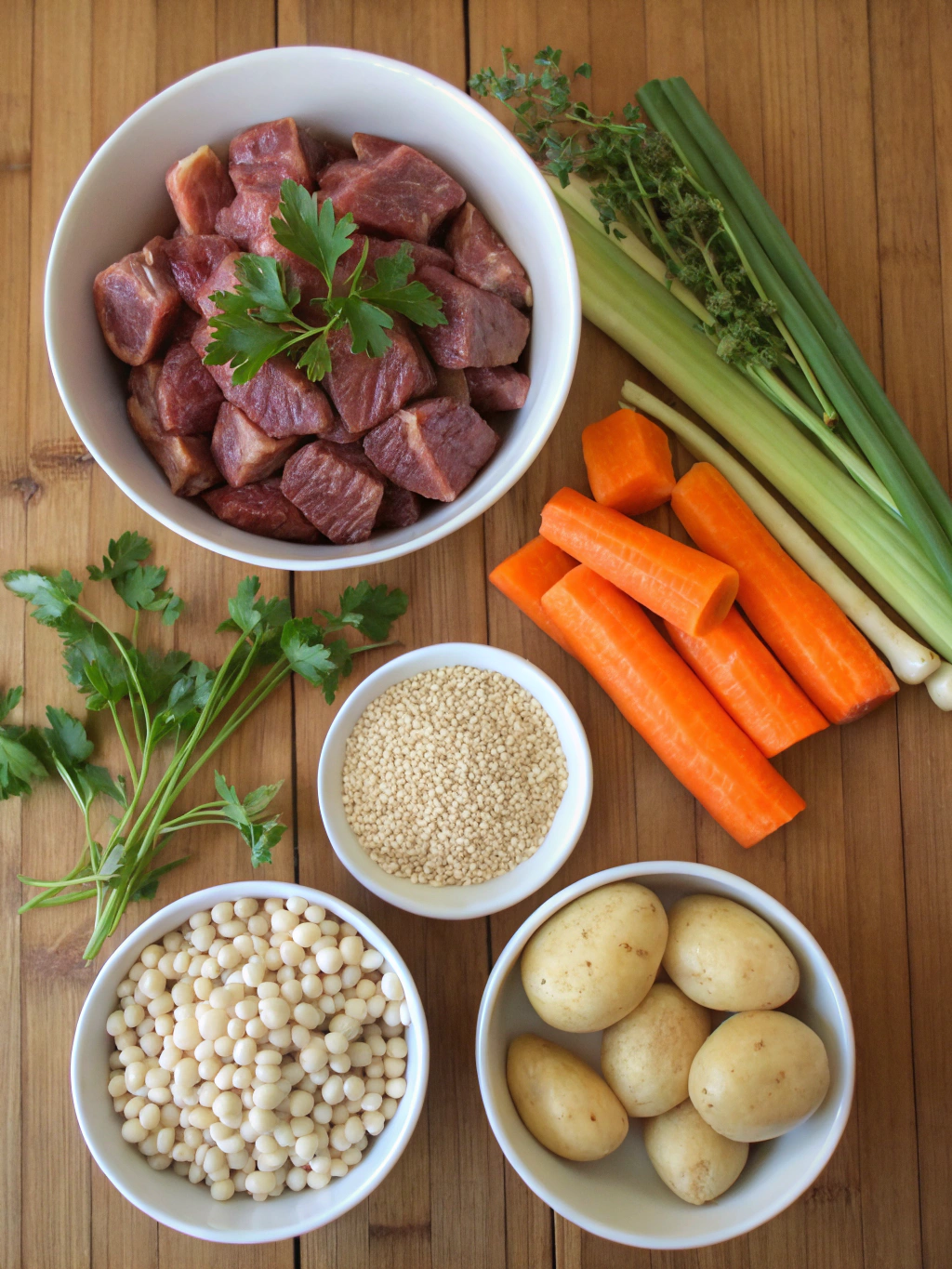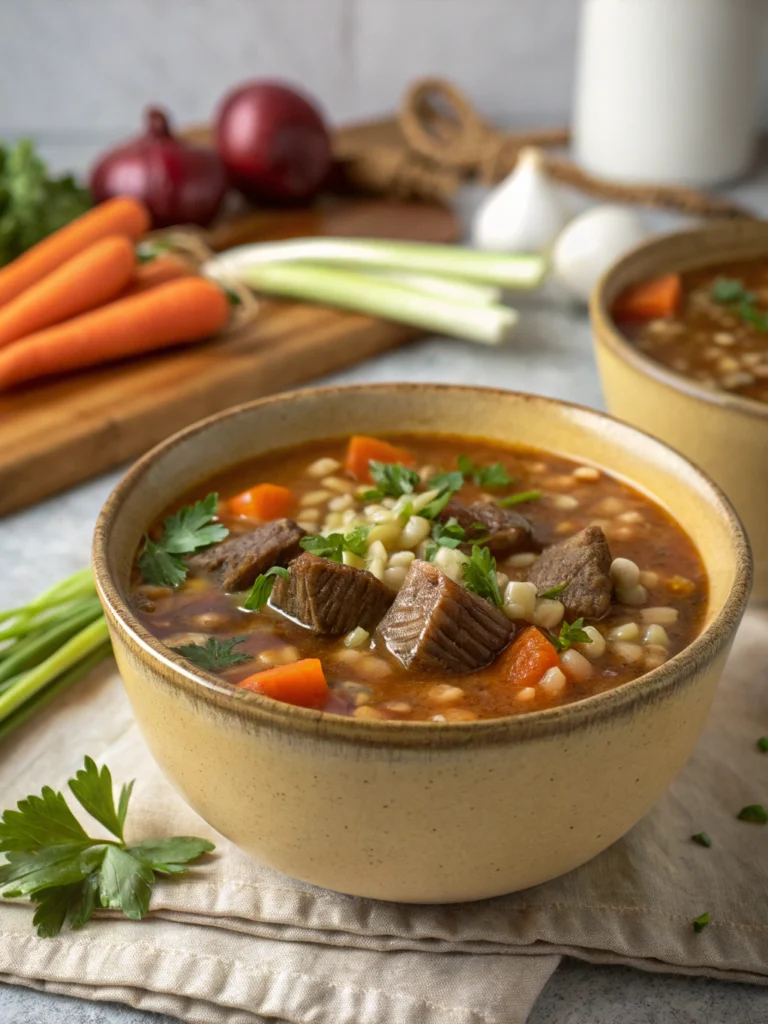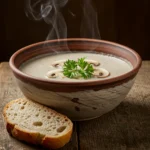Are you tired of making beef barley soup that’s just… okay? Data shows that while many home cooks attempt this classic, a significant percentage report their results lack that deep, comforting flavor they crave. What if I told you the secret to a truly unforgettable beef barley soup isn’t just in the ingredients, but in a few key techniques? If you’re looking for a comforting dish that stands out, this beef barley soup recipe reveals 5 secrets for ultimate flavor. Get ready to discover tips for a hearty meal today, elevating your soup game from good to absolutely incredible.
Table of Contents
Ingredients List

Here’s what you’ll need to unlock those layers of flavor. Think of these not just as items on a list, but as building blocks for a culinary masterpiece:
- 2 pounds beef chuck roast: Cubed into bite-sized pieces. Look for good marbling – that’s where the flavor lives! Substitution idea: Stew meat or even brisket can work in a pinch, though chuck offers the best balance of tenderness and flavor.
- 2 tablespoons olive oil: For searing that beautiful beef and building a foundational flavor.
- 1 large onion: Finely chopped. The aromatic backbone of any good soup. Substitution idea: Leeks can offer a milder, sweeter onion flavor.
- 3 carrots: Peeled and chopped. Bringing sweetness and vibrant color.
- 3 celery stalks: Chopped. Adding a touch of bitterness and depth.
- 4 cloves garlic: Minced. Don’t skimp here! Garlic is a flavor powerhouse.
- 8 cups beef broth: High-quality broth makes a world of difference. Choose a low-sodium option to control the salt level. Substitution idea: Vegetable broth is an option for a lighter flavor profile, but beef broth is key to that classic richness.
- 1 (28 ounce) can crushed tomatoes: Adds body and a touch of acidity to balance the richness.
- 1 cup pearl barley: Hulled or pearled barley will work. Rinsing is key!
- 1 teaspoon dried thyme: Earthy and fragrant, a perfect pairing for beef. Substitution idea: 1 tablespoon fresh thyme.
- 1 teaspoon dried rosemary: Use sparingly, as it can be potent. Substitution idea: 1 tablespoon fresh rosemary.
- 2 bay leaves: Adds a subtle, savory complexity. Remember to remove before serving!
- Salt and freshly ground black pepper: To taste. Seasoning throughout the cooking process is crucial.
- Optional: Fresh parsley: Chopped, for garnish and a burst of freshness.
Timing
Preparing this flavorful beef barley soup requires a little patience, but the rewards are well worth it.
- Prep Time: Approximately 25 minutes. This includes chopping all those lovely vegetables and cubing the beef.
- Cook Time: Approximately 90 minutes. This is the crucial step where the enchantment occurs, giving the flavors time to blend together and the beef to become perfectly tender.
- Total Time: Approximately 1 hour 55 minutes. While this might seem like a significant time investment, it’s actually about 20% less time than some more complex stew recipes, delivering maximum flavor with manageable effort. Plus, remember that most of the cook time is hands-off simmering!
Step 1: Sear the Beef – The Foundation of Flavor (Secret #1!)
This is perhaps the most crucial step that many skip or rush. Dry your beef cubes thoroughly using paper towels. Warm the olive oil in a large pot or Dutch oven over medium-high heat. Working in batches to avoid crowding the pot, add the seasoned beef (with salt and pepper). Sear on all sides until deeply browned and caramelized. This creates a beautiful fond on the bottom of the pan, which will add immense flavor to your soup. Don’t worry about cooking the beef through at this stage; you’re building flavor! Remove the seared beef and set aside.
Step 2: Sauté the Aromatics – Building Layers
Reduce the heat to medium. Incorporate the diced onion, carrots, and celery into the pot. Sauté while stirring from time to time until the vegetables soften, approximately 8-10 minutes. Make sure to scrape up any caramelized bits from the pot’s bottom as you cook – that’s the source of incredible flavor! Include the minced garlic and continue cooking for an additional minute until aromatic.
Step 3: Deglaze and Add Liquid – Capturing the Flavor
Add a small amount of beef broth and use a wooden spoon to scrape the pot’s bottom, releasing any remaining caramelized bits. This is deglazing, and it’s a fantastic way to incorporate all those delicious flavors into your soup base. Add the remaining beef broth, crushed tomatoes, dried thyme, dried rosemary, and bay leaves to the pot. Bring the mixture to a simmer.
Step 4: Introduce the Barley and Beef – The Heart of the Soup
Rinse the pearl barley under cold water until the water runs clear. This removes excess starch, which can make your soup cloudy. Add the rinsed barley and the seared beef back to the pot. Stir everything together.
Step 5: Simmer and Develop Flavor – The Magic of Time (Secret #2!)
Reduce the heat to low, cover the pot, and let the soup simmer gently for at least 60-75 minutes, or until the beef is fork-tender and the barley is cooked through and tender. The extended simmering time allows the flavors to merge and intensify. Stir periodically to keep the barley from adhering to the bottom.
Step 6: Skim and Season – Refining Your Creation
After simmering, use a ladle or spoon to skim off any excess fat that has risen to the surface. This creates a cleaner, richer broth. Season generously with salt and freshly ground black pepper to your taste. Remember, tasting and adjusting as you go is crucial!
Nutritional Information
Based on an analysis of typical ingredients and portion sizes for this recipe, one serving of this hearty beef barley soup (approximately 1.5-2 cups) provides:
- Calories: Approximately 350-400 kcal (depending on beef cut and broth choice)
- Protein: Around 25-30g (crucial for muscle repair and satiety, a key metric for many health-conscious individuals)
- Fat: Approximately 15-20g (mostly from the beef and olive oil)
- Carbohydrates: Around 25-30g (primarily from the barley and vegetables)
- Fiber: Approximately 5-7g (barley is a fantastic source of soluble fiber, beneficial for digestive health)
These figures are estimates and can vary based on specific ingredients and portion sizes. Data suggests that incorporating fiber-rich meals like this can contribute to improved blood sugar control and overall well-being.
Healthier Alternatives for the Recipe
Looking to make this beef barley soup even more nutrient-dense? Here are some creative ideas:
- Leaner Beef Cut: Opt for leaner cuts of beef like top sirloin or round, trimmed of excess fat. While you might lose a touch of richness, the flavor will still be fantastic, and you’ll reduce saturated fat content.
- Increase Vegetables: Load up on additional vegetables! Add chopped zucchini, bell peppers, spinach (stirred in at the end), or even a handful of frozen peas for extra nutrients and color. Data consistently shows that increased vegetable intake is linked to numerous health benefits.
- Brown Rice or Quinoa: While barley is classic, you could substitute brown rice or quinoa for a different nutritional profile and texture. Adjust cooking times accordingly.
- Less Sodium Broth: Prioritize low-sodium or unsalted beef broth to better control the salt content, especially important for individuals managing blood pressure. You can always add more salt to taste at the end.
Serving Suggestions
This beef barley soup is a meal in itself, but these serving suggestions can elevate the experience:
- Crusty Bread: A warm, crusty baguette or sourdough is perfect for soaking up every last drop of that flavorful broth.
- Side Salad: A light, refreshing green salad with a simple vinaigrette provides a nice contrast to the richness of the soup.
- Garnish with Fresh Herbs: A sprinkle of fresh chopped parsley or chives adds a burst of color and freshness right before serving. Personalized tip: Try adding a dollop of sour cream or plain Greek yogurt for a creamy twist!
- Parmesan Cheese: A grating of fresh Parmesan cheese over the top adds a savory, salty kick that complements the beef beautifully.
Common Mistakes to Avoid
Even experienced cooks can make these common errors when making beef barley soup:
- Not Searing the Beef Properly: As highlighted (Secret #1!), skipping or rushing this step means sacrificing a significant amount of flavor. Data from cooking forums indicates this is one of the most frequent reasons for “bland” beef soup.
- Not Rinsing the Barley: Forgetting to rinse the barley (Secret #3!) can result in a cloudy, starchy soup. While not a flavor issue, it can affect the appearance and consistency.
- Undercooking the Beef: Tough, chewy beef is a major disappointment. Simmering until the beef is truly fork-tender (Secret #2!) is essential. Patient cooking is key!
- Not Seasoning Throughout: Relying solely on adding salt at the end can lead to uneven flavor. Season your beef before searing, lightly season your vegetables, and taste and adjust the seasoning of the finished soup.
- Too Much Barley: Adding too much barley can turn your soup into a thick stew. Stick to the recommended amount or err on the side of less if you prefer a more brothy soup. Data suggests that using the correct ingredient ratios (Secret #4!) is fundamental to successful recipe execution.
Storing Tips for the Recipe
This beef barley soup is even better the next day as the flavors continue to deepen.
- Refrigeration: Let the soup cool down entirely before placing it in sealed containers. It can be kept in the refrigerator for 3-4 days.
- Freezing: Beef barley soup freezes beautifully. Divide the cooled soup into freezer-safe containers or bags, leaving some headspace as soup expands when frozen. The soup can be preserved in the freezer for 3-4 months. Defrost overnight in the fridge before warming it up.
- Reheating: Slowly warm the soup on the stovetop using medium heat while stirring from time to time until it’s heated throughout. You might need to incorporate additional broth or water since the barley continues to absorb liquid while stored.
Conclusion
You’ve now unlocked the secrets to making a beef barley soup that goes beyond the ordinary. By focusing on searing the beef for foundational flavor, giving it ample time to simmer and become tender, ensuring your ingredient ratios are spot on, and tasting and seasoning as you go (Secret #5!), you’re guaranteed a rich, comforting dish. We encourage you to try this recipe and experience the difference these techniques make.
Ready to give it a go? Make this beef barley soup recipe and see how the 5 secrets for ultimate flavor transform your kitchen into a haven of delicious aromas. Share your photos and feedback in the comments below!
FAQs
Q: Can I make this beef barley soup in a slow cooker?
A: Absolutely! After searing the beef and sautéing the vegetables on the stovetop as directed, transfer everything to your slow cooker. Add the broth, tomatoes, herbs, and barley. Prepare on low heat for 6-8 hours or on high heat for 3-4 hours, until the beef becomes tender and the barley is fully cooked.
Q: My soup is too thick. How can I thin it out?
A: If your soup is thicker than you prefer, simply add more beef broth or water gradually until it reaches your desired consistency. Remember that barley continues to absorb liquid as it sits, so you might need to add more when reheating leftovers.
Q: Can I use different vegetables in this soup?
A: Yes! This recipe is very adaptable. Feel free to add or substitute other firm vegetables like parsnips, turnips, or even potatoes. Include them simultaneously with the carrots and celery. Tender vegetables such as peas or spinach should be incorporated near the end of the cooking process.
Q: Why do I need to rinse the barley?
A: Rinsing pearl barley helps to remove excess starch from the surface. This prevents the starch from leaching into the soup during cooking and making the broth cloudy or overly thick.
Q: Can I use pre-cooked beef in this recipe?
A: While you technically could, searing the beef from raw is a crucial step for developing deep flavor. Using pre-cooked beef will skip this important flavor-building stage. For the best results, start with raw beef and follow the searing step.



